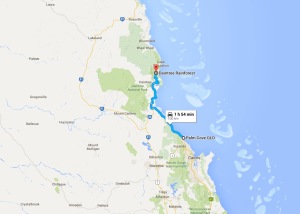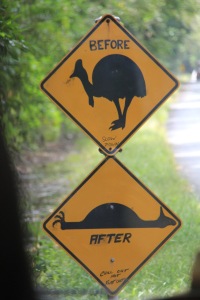Wednesday, Feb 24, 2016
I had organized a full-day rain forest tour, which started at 7:30 am. It was overcast, a little cooler ( 25 C or 77 F ) and less humid in the morning, when I was picked up by the tour van.
As we drove the 60 km to the Daintree Rainforest Park, our guide informed us about the area, its history, the plants, the animals and the people.
For instance, our guide explained that this time of year is the peak season for the ” stingers “, such as the box jellyfish which is known as the deadliest animal alive, 3 times the venom strength of the deadliest Australian snake, although there are very few deaths attributed to contact with it. That is why they have the stinger nets on the beaches in this area during the warm months. They aren’t required in the winter ( May to September ), when the weather is warm, instead of being hot and currently the water temperature is 32 C ( 90 F ). The jellyfish are ” delicate ” creatures and are usually not swimming around in rough weather, which explains why you don’t see people swimming in the Coral Sea when it is calm. If you are want to swim, the best time is when there are a lot of waves, but you still need to keep inside of the swim nets.
He also showed us the usefulness of many of the plants in the jungle. One unique feature is the barbs on the ” feelers ” that some ferns use to climb up the trees in the forest to get to the upper canopy. These tentacles were used by the aboriginals for hooking something. They would use them to extract something from a burrow or narrow opening, as well as, for fishing.
In fact, even the bottom of the fronds have large, spiked barbs.
Our guide was very informative and he made it an interesting day. I, especially, enjoyed being able to see some of the wildlife, without the constraints of the zoo enclosures.
We were very fortunate to see Cassowaries. The Cassowary is a flightless bird that is native to the tropical forests of New Guinea, nearby islands, and northeastern Australia. It is the third tallest and second heaviest living bird, smaller only than the ostrich and emu and it is on the brink of extinction in Australia.
We saw one Cassowary at the beginning of our tour, just as we were leaving a forest trek and later we saw this one as we were leaving the forest.
Being hit by cars, is the leading cause of death for the Cassowary in Australia and therefore the government has put up signs, like this one, to get people to slow down.
I also saw several, very large spiders along the way. These are some of my favourites.
Our guide pointed out this spider, but I couldn’t see it because of its camouflage, until he pointed it out to me.
We were also taken on a river cruise and the guide explained the different types of mangroves, their importance and how they function along the river bank to clean the water, secure the banks from erosion and create a habitat for wildlife.
After we had lunch in the forest, our guide showed us this fellow hanging on to a nearby tree.
The lizard barely moved the whole time we were there, although he did turn his head a few times to look away from us.
By the late afternoon, we had reached our final destination, Cape Tribulation. During our ride there, our guide explained how Captain Cook ran his ship aground on the reef that connects to the shore at this point and how he was able to free his ship and repair it before continuing his voyage.
I found it to be a very interesting tour and I took some notes so I could explain it, but the best way to find out about this adventure, is to experience it first-hand.
We arrived back at Port Douglas after 5 pm and it took another 45 minutes to get back to the resort, where I tried to assimilate all of the information I had been given.
Tomorrow, I plan to relax before I fly to Sydney for my last 4 days in Australia.











Great photos Ralf….thanks….
Sounds as though you’re having a very enjoyable time.
Yes. I am definitely enjoying my time here.